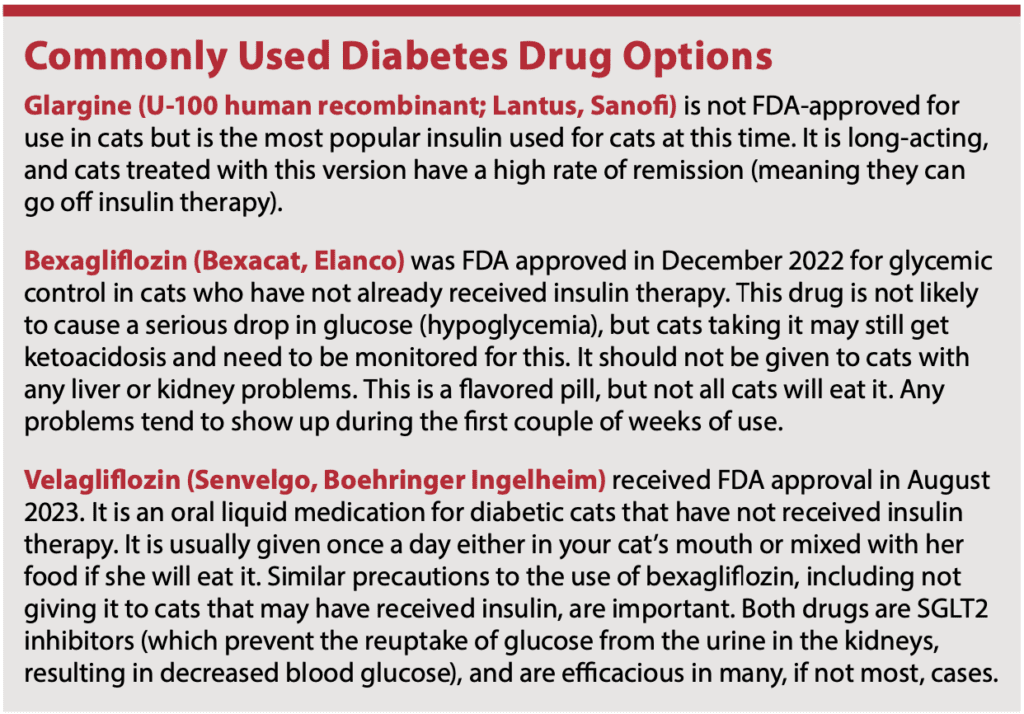Ask anyone who has a diabetic cat and you may well hear about fights with the cat over basic care and treatment. While daily insulin injections are no fun for anyone, advancements in veterinary medicine have made caring for diabetic cats a bit easier than in the past.
Appropriate insulin/antidiabetic medication, a low-carb diet, careful weight loss, an exercise program (even in the form of more play), and sticking to a regular and low stress daily routine can help your cat to achieve diabetic remission and stay healthy.
Leni Kaplan, DVM, senior lecturer in the section of community practice service at Cornell University’s College of Veterinary Medicine, stresses that you are the most important part of your cat’s diabetes health-care plan. Dr. Kaplan offers these three tips for monitoring and caring for your diabetic cat at home:
υ Follow diet recommendations from your veterinarian, since diet plays such a crucial role in managing diabetes.
ϖ Change bottles of insulin at least every few months and do not re-use needles, as this may contaminate the insulin and shorten its shelf life.
ω If your cat is not eating, is lethargic, vomits, or has diarrhea, do not give insulin and seek out emergency veterinary consultation immediately.
The care of diabetic cats relies heavily on informed, capable owners. Dr. Kaplan believes home observation can sometimes replace repeating blood glucose curves, which require trips to the veterinarian’s office and an overnight stay.
“I’m going a bit rogue here,” says Dr. Kaplan, “but, once the diabetes is successfully managed, I usually don’t do BG (blood glucose) curves. Instead, I usually have owners monitor their cats for symptoms of diabetes, including increased thirst (finding them at the water bowl or licking out the shower), increased urination (larger than usual clumps in the litterbox and/or so much fluid in the litterbox that the litter is floating and/or if their cat’s paws get caked with litter), and change in appetite (asking for more food than usual and/or not eating). If any of these occur, then I know we need to investigate their diabetic control.”
You may need to do some home monitoring of glucose levels, however, using a glucometer and test strips. Alpha Trak 2 by Zoetis is a glucometer designed for cats (and dogs). An ear prick is generally the best way to get the drop of blood you need.
Once your cat is stable, you can often monitor by clinical signs or a monitoring tool such as the Freestyle Libre or Guardian RT Real Time Continuous Glucose Monitor. These work for approximately two weeks, but your cat must be agreeable to wearing the monitor and leaving it alone.
Traditional Care Still Matters
Remember that treatment for diabetes involves controlling several symptoms, including polyuria and polydipsia (drinking and urinating excessively), polyphagia (increased appetite), and nerve disorders.
Your cat will become more active and restore muscle mass with correct therapy. You want to avoid emergencies like low blood sugar (hypoglycemia) and ketosis (a metabolic disorder where the body uses fat instead of glucose for energy).
Important aspects of treatment include feeding a carbohydrate-restricted diet, achieving and maintaining a healthy body weight, encouraging regular exercise, and minimizing stress by following regular daily routines.

Handling Insulin Therapy
Most cats, at least initially, will need two insulin injections daily (see sidebar for information on newer oral treatment options for cats who have yet to receive insulin). Before starting any insulin therapy, your cat should have a blood glucose curve done. This means a hospital stay for a day, with multiple blood samples to check how your cat handles glucose and insulin over the day. Your veterinarian may recommend periodic glucose curve hospital stays if your cat does not seem to stabilize and her clinical signs fluctuate. Cats tend to complicate glucose level monitoring, as they tend to become hyperglycemic when stressed (even healthy cats do this).
Insulin doses are initially based on your cat’s ideal weight. Most cats require some fine tuning to get the best dose, best type of insulin, and best dosing schedule. Fructosamine levels can be done via a blood test at the vet clinic to give you an idea of control of blood glucose levels over the past month.
Don’t be discouraged if there is a period of trial and error to get the best protocol for your cat. With your observation and dedication, you can usually achieve it.
Owners should never be bashful about asking for more information about their cat’s condition, including what to do if the cat skips a meal, is a picky eater, and so on. Make sure you ask for a demonstration and an opportunity to practice giving your cat injections in front of experienced veterinary staff (or the doctor) so you set yourself and your pet up for success.
Remission Is Possible
The goal is clinical remission, which means your cat no longer needs insulin or one of the oral medications to control her blood sugar levels. The best odds for remission follow the use of long-acting insulin and a low carb diet. Most diabetic cats do best on a canned low-carb diet.
You may learn that your cat is in remission when her fructosamine or blood glucose curves show her glucose levels dropping. If this trend is starting, your veterinarian will guide you about how to gradually lower your cat’s medication dosage.




